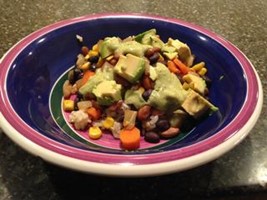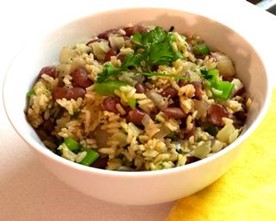Rural Healthy Eating
Living in rural areas may make it more difficult to eat healthfully. There may not be a supermarket or large grocery store nearby and foods at smaller stores may be more expensive. Below are ways that may help reduce barriers to healthy eating in rural areas.
- Find out if there is a local farmers market nearby. It may be closer than a grocery store. Some markets accept SNAP or WIC benefits.
- Amish, Mennonite, or similar communities may have small grocery stores or markets closer to you than traditional markets. Determine whether food cost savings and cost of gas make shopping at these markets a good choice.
- Small, local farms may sell eggs, milk, meat, or produce.
- Have a garden at home or participate in a community garden. If there isn't a community garden available, work on starting one. Another alternative is to grow vegetable plants indoors - many types of vegetables can be grown on sunny windowsills. Seeds and vegetable plants can be purchased with SNAP benefits.
- If you end up with too much produce, preserve it to have available throughout the year. Canning, smoking, freezing, and drying are some options for preserving foods.
- Hunting, fishing, and gathering may be possibilities. If your family doesn't hunt, you may be able to buy meat from other local families who have more than they need. If berries are available in your area, plan a time to go berry-picking.
- Look for local foods and local farmers markets at: https://abundantmontana.com
- For a list of Montana farmers markets and other locations that offer the opportunity to double your SNAP dollars, go to: https://www.doubledollarsmt.com
Overcoming transportation issues
- Carpool with a friend, neighbor, or coworker. Take turns driving or if only one person has a vehicle, the other person could help with gas.
- Check with your local grocery store and community groups to see if they offer any free public transportation options.
- Plan ahead and go to the grocery store once a week or less. This will save on fuel costs and your time.
- Check to see if your town has a local co-op or ordering club to split the cost of big orders. Calculate costs to make sure this is a good option.
- See if any larger grocery stores or other companies deliver to your area. Determine if delivery costs are the same or less than the cost of fuel to travel to the store.
Information adapted from Michigan State University Extension article 'Overcoming barriers to living in a food desert.'
9 tips to save money on food
- Plan meals ahead of time. You could even plan meals with your carpooling buddy to purchase bulk items together and split the amount and the cost.
- Use grocery store ads to determine what meals to cook for the week. If you don't have access to a newspaper, looking online may be another option.
- If you buy fresh produce, use it during the first few days since it can spoil faster than canned or frozen fruits and vegetables.
- Fruit and vegetables that last the longest include hardy root vegetables like potatoes, sweet potatoes, carrots, and beets, as well as produce with durable skin, like winter squash, apples, and bananas
- Frozen fruits and vegetables may be better options if fresh produce is wilted or no longer looks fresh.
- When ingredients aren't available or are too expensive, substitute available ingredients that are reasonably priced. See our fact sheet Swapping Out Plant Parts for ideas to substitute available produce in recipes.
- Stock up on sale items.
- Check the unit price. This price is usually listed next to the price of the item and tells you how much an item costs per pound, ounce, quart, etc. That way you can compare different sizes of the same product.
- Keep an organized fridge. This will help avoid wasting leftovers and produce. See our fact sheet Storing Fruits and Vegetables for more tips and tricks to keep food fresh.
Save money on ingredients
- Beans and whole grains are inexpensive ways to bulk up meals and can be main dishes by themselves.
- Buy dried beans instead of canned.
- Buy blocks of cheese, shred it, and freeze it in two cup quantities to use in recipes.
- Consider making homemade yogurt and bread.
- Put together your own trail mix.
- Try less expensive cuts of lean meat.
- Choose hot cereals like plain oatmeal instead of dry cereals.
- Skip the chips and cookie aisles.
- Skip sugar-sweetened drinks and stick to water.
Resources
There are many resources for healthy eating on a budget. Here are a few:
- Meeting Your MyPlate Goals on a Budget:https://www.myplate.gov
- Eat Right When Money's Tight Tip Sheet USDA SNAP-Ed Connection: https://snaped.fns.usda.gov/snap/EatRightWhenMoney'sTight.pdf
- Supermarket Savings: 16 Tips that Total BIG Bucks from the University of Nebraska-Lincoln Extension: https://extensionpublications.unl.edu/assets/pdf/g1933.pdf
Featured Recipes
Create Your Own Rice and Beans BowlHeat oil over medium-high heat in a skillet. Add in vegetables, sauté until tender. Stir occasionally to keep from burning.Add beans and desired spices. Heat through.In a bowl, place a scoop of rice and top with beanmixture. Add any sauce and garnishes you choose. |
 |
Red Beans and RiceIn a medium skillet, melt butter over medium heat. Add onion, celery, and garlic and cook until tender.Add beans, rice, parsley, salt, and pepper. Simmer together for 5 minutes to blend flavors. |
 |


 You may require
You may require